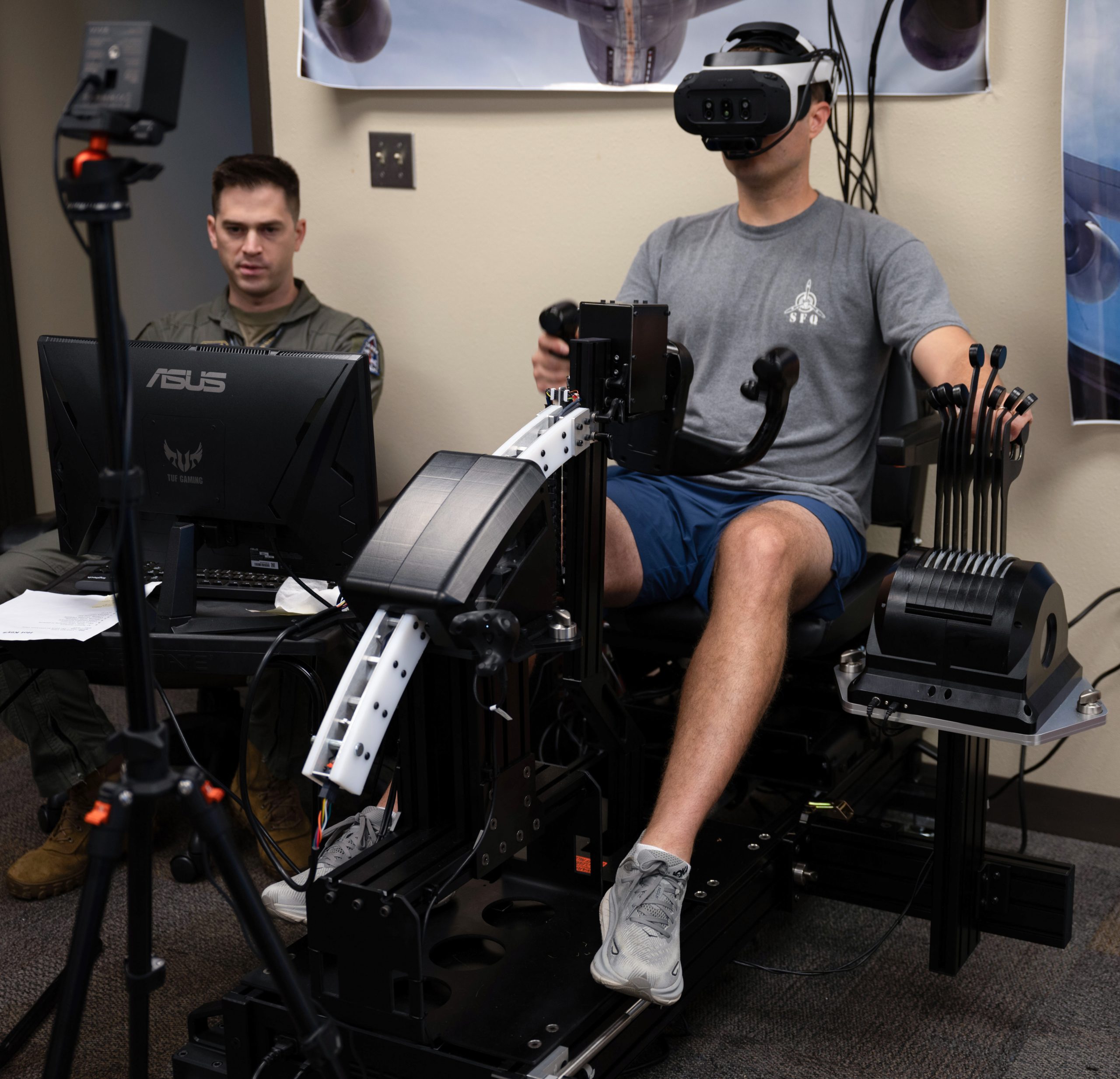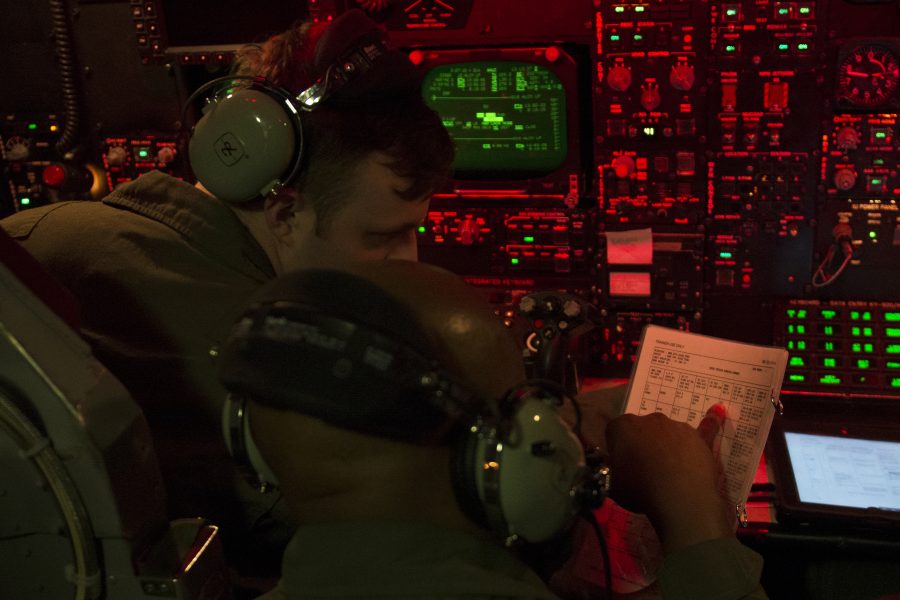Air Force B-52 program officials are gunning for a budget boost for new simulators that can adequately replicate challenging tasks crew members must perform on real-world bombing missions.
The 2026 base budget request includes $20 million for research and development of the B-52 Mission Employment Trainer, which would upgrade and eventually replace today’s antiquated B-52 Stratofortress crew trainers. The House Appropriations Committee, in its proposed 2026 defense budget, recommended $26.2 million to develop high-fidelity simulators for the B-52H in order to help offset the high cost of live flight training.
Air Force Global Strike Command has been exploring options for Stratofortress simulators since 2022. The B-52 has been in service for 61 years and is expected to remain in service for decades. It remains a critical part of the Air Force’s strategic long-range bombing capability. USAF is investing millions to update the BUFF into a new B-52J configuration, with new engines and new radars. Its goal is to achieve initial operating capability in 2033.
B-52 simulators have not kept up with improvements to the bomber, and today’s 30-year-old simulators at Barksdale Air Force Base, La., are unable to realistically prepare Airmen for key cockpit scenarios before they take their first live flight, said Maj. Linwood Steiner, assistant director of Operation at the 11th Bomb Squadron there.
“At the end of the day, a simulator’s effectiveness as a training tool is directly correlated to the precision with which it mimics the total flying experience,” Steiner told Air & Space Forces Magazine. “In the case of the B-52 [simulator,] its effectiveness as a training tool is very limited when it does not realistically mimic what the actual aircraft is like.”
The 11th Bomb Squadron oversees the nine-month initial qualification course for new B-52 crew members. During the course, students spend about 90 hours in the simulators and an equal amount of hours flying 15 missions in B-52s.
The simulators are still a very effective training tool for weapons system officers and it enables crews to train on procedures for their nuclear mission, Steiner said. It is also a “great place for pilots to be handed situations that are way too dangerous to practice in flight. … You’re able to throw in any emergency procedure that you could ever see. … You can layer emergencies on top of each other, and you can give those emergencies during critical phases of flight, like take off, landing and a low altitude environment.”
But the simulators do not prepare crew for aerial refueling, a critical mission requirement on any long-range flight.
“It’s pretty important for the B-52’s ability to strike targets anywhere in the world within 48 hours,” Steiner said. Refueling is dangerous and it’s a challenge to simulate what it is like to fly “10 feet behind another massive airplane with all of the downdraft associated with aerodynamics. It just becomes a volatile situation.”
Steiner recalled the first time he attempted to refuel in a B-52, a task the former T-38 Talon instructor did not expect to be that challenging.
“I get to the B 52 and everybody’s talking about how hard [aerial refueling] is, and I’m like, just put me behind a tanker,” he recalled. “So I get behind a tanker, and I am flabbergasted at how difficult it is. … I immediately think I’m the worst pilot that’s ever flown.”
The B-52’s wing-mounted spoilers are slow to respond, making it hard to adjust while flying at 400 miles per hour Steiner said. It can take some students 15 flights to become proficient.
In 2022, course officials developed a virtual-reality training device, the Experiential Air Refueling Lightweight Simulator, to familiarize students with refueling the BUFF. Seated in a chair, students don virtual-reality goggles and work with a makeshift yoke and 3-D-printed throttles to practice.

The training device is hardly high-fidelity, but it helps, Steiner said. “So if we have that in a high-fidelity [simulator,] it would be monumental.”
Today’s simulators lack many existing B-52 updates, including communications and navigation equipment and the multifunction cockpit display. These updates were never added to the simulators, diminishing how realistic the training is for modern crews.
Updating simulators cuts down significantly on the number of training flights needed to qualify on an airplane. For example, students “complete their initial qualification [on a B-2 Spirit bomber] in about six flights, whereas on the B-52, it takes 15 flights,” Steiner said. It costs about $88,000 per flight hour to fly the B-52 so each hour saved is significant.
The B-52J will require a whole new simulator when it reaches the fleet in the early 2030s, Steiner said. New engine pylons, new radars, an alldigital backbone and new communications and navigation equipment will each make a difference.
“The changes are so significant that this simulator will not even be able to realistically simulate the actual aircraft at all,” Steiner said.
A spokesman said Air Force Global Strike Command “is currently assessing options to build new, state-of-the-art, simulators; potential courses of action include updating existing simulators or developing new high-fidelity full-motion simulators for pilots and combat systems operators,” according to a a written statement provided by a spokesperson.
Air Force Life Cycle Management Center’s Simulator System Program Office released requests for information to industry for a medium-fidelity, non-motion simulator in 2024 and for the high-fidelity motion simulator in 2025.
High-fidelity, full-motion simulators provide a cockpit scenario that’s identical to the real aircraft, so pilots and crew will feel like they are flying in a B-52, the spokesman said.
“The realism will be especially good for pilots who can train for takeoff, landing, and air refueling in the simulator at a fraction of the cost of flying the aircraft,” the spokesman said.
Medium-fidelity, non-motion simulators have virtualized buttons and switches on touch screens rather than true instrument panels. They are rapidly reconfigurable with very few hardware components. The cockpit software can be reconfigured from a B-52-H to the J model multiple times a day, the spokesman said.
Global Strike Command would not provide specific details on a timeline, but the spokesman said “our requirements have already been sent out to industry for bid. The next step is to decide which company or companies can build the simulators we need, in the timeframe that we need them, and for a cost that is fair to the taxpayer.”
To Steiner, full motion, high-fidelity simulators are desirable but not a must have. Medium fidelity simulators “would give you that highly customizable, more modern, updatable type of a platform that would give us at least something that perfectly mirrors the [B-52’s] equipment and the switchology and software. … We would much rather have that than a hydraulic stand that gives us motion.”


